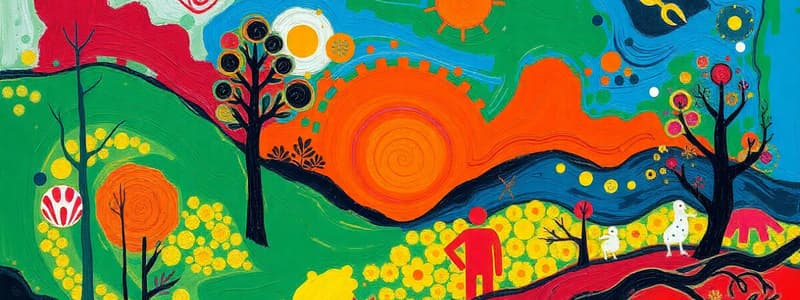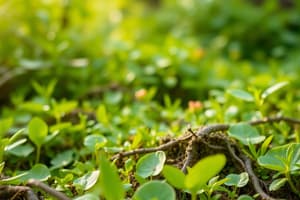Podcast
Questions and Answers
What is the main function of decomposers in an ecosystem?
What is the main function of decomposers in an ecosystem?
- To produce energy through photosynthesis
- To compete for food resources
- To create food from chemicals in deep-sea environments
- To recycle nutrients back into the ecosystem (correct)
Which factor is NOT an abiotic component of an ecosystem?
Which factor is NOT an abiotic component of an ecosystem?
- Water
- Bacteria (correct)
- Temperature
- Soil
What is the term for the maximum population size that an environment can sustain?
What is the term for the maximum population size that an environment can sustain?
- Exponential growth
- Eutrophication
- Carrying capacity (correct)
- Climax community
Which process refers to organisms creating food from chemicals instead of sunlight?
Which process refers to organisms creating food from chemicals instead of sunlight?
What phenomenon describes the process of water bodies becoming overly enriched with nutrients?
What phenomenon describes the process of water bodies becoming overly enriched with nutrients?
Which layer of the Earth is involved in tectonic movements?
Which layer of the Earth is involved in tectonic movements?
What is the greenhouse effect primarily caused by?
What is the greenhouse effect primarily caused by?
What characterizes a climax community?
What characterizes a climax community?
What does logistic growth in a population indicate?
What does logistic growth in a population indicate?
Which of the following best describes mutualism?
Which of the following best describes mutualism?
What is a primary cause of global warming?
What is a primary cause of global warming?
What is the primary consequence of nonrenewable resource consumption?
What is the primary consequence of nonrenewable resource consumption?
How does the predator-prey relationship influence population dynamics?
How does the predator-prey relationship influence population dynamics?
What effect can human activity have on the nitrogen cycle?
What effect can human activity have on the nitrogen cycle?
In which situation does primary succession occur?
In which situation does primary succession occur?
What does a survivorship curve represent?
What does a survivorship curve represent?
What characterizes a negative feedback loop in an ecological context?
What characterizes a negative feedback loop in an ecological context?
Which of the following statements about energy transfer in trophic levels is true?
Which of the following statements about energy transfer in trophic levels is true?
Flashcards
Carrying Capacity
Carrying Capacity
The maximum population size an environment can sustain due to available resources.
Chemosynthesis
Chemosynthesis
The process by which certain organisms create food from chemicals (rather than sunlight), often found in deep-sea ecosystems.
Climax Community
Climax Community
The final, stable community in an ecosystem, following ecological succession.
Atmosphere
Atmosphere
Signup and view all the flashcards
Commensalism
Commensalism
Signup and view all the flashcards
Carbon Cycle
Carbon Cycle
Signup and view all the flashcards
Decomposers
Decomposers
Signup and view all the flashcards
Eutrophication
Eutrophication
Signup and view all the flashcards
Immigration
Immigration
Signup and view all the flashcards
Limiting Factors
Limiting Factors
Signup and view all the flashcards
Logistic Growth
Logistic Growth
Signup and view all the flashcards
Migration
Migration
Signup and view all the flashcards
Mutualism
Mutualism
Signup and view all the flashcards
Negative Feedback Loop
Negative Feedback Loop
Signup and view all the flashcards
Nitrogen Cycle
Nitrogen Cycle
Signup and view all the flashcards
Nonrenewable Resources
Nonrenewable Resources
Signup and view all the flashcards
Parasitic
Parasitic
Signup and view all the flashcards
Photosynthesis
Photosynthesis
Signup and view all the flashcards
Study Notes
Abiotic Factors
- Non-living parts of an ecosystem (e.g., temperature, light, water, soil) influence organisms
Atmosphere
- The layer of gases surrounding Earth, crucial for life and shielding from harmful radiation
Asthenosphere
- Earth's mantle layer, beneath the lithosphere, involved in tectonic movements
Biotic Factors
- Living components of an ecosystem (e.g., plants, animals, bacteria)
Biosphere
- Global sum of all ecosystems, encompassing all living organisms and their environments
Carbon Cycle
- Carbon movement through Earth systems (atmosphere, biosphere, oceans)
- Human activities (fossil fuel burning) increase CO2, impacting global warming
Carrying Capacity
- Maximum population size an environment can sustain
Chemosynthesis
- Process where organisms create food from chemicals (not sunlight), common in deep-sea ecosystems
Climax Community
- Final, stable community in an ecosystem after ecological succession
Commensalism
- Symbiotic relationship where one benefits, the other is unaffected
Common Sources of Phosphorus
- Found in rocks, soil, minerals, essential plant nutrient
Consumers
- Organisms that obtain energy by consuming other organisms (primary, secondary, etc.)
Decomposers
- Organisms (bacteria, fungi) that break down dead organisms, recycling nutrients
Eutrophication
- Water bodies become overly enriched with nutrients, harming aquatic life due to oxygen depletion
Extinction
- Permanent loss of a species
Exponential Growth
- Rapid population growth due to abundant resources, J-shaped curve
Evolutionary Success
- Species well-adapted to its environment, ensuring survival and reproduction
Function of Carbon Dioxide
- Key greenhouse gas, contributing to warming; essential for photosynthesis
Geosphere
- Earth's solid components (rocks, landforms)
Genetic Drift
- Random changes in allele frequencies in a population, impacting evolution
Greenhouse Effect
- Greenhouse gases trap heat in Earth's atmosphere, leading to global warming
Habitats
- Natural environments where organisms live, providing resources for survival and reproduction
Hydrosphere
- All Earth's water (oceans, lakes, rivers, groundwater)
Immigration
- Movement of individuals into a population, increasing its size
Limiting Factors
- Environmental factors restricting population growth (e.g., food, water, space, predators)
Lithosphere
- Earth's outermost layer (crust, upper mantle), involved in tectonic movements
Logistic Growth
- Population growth slowing as it approaches carrying capacity, S-shaped curve
Main Causes of Global Warming
- Primarily human activities (fossil fuel burning, deforestation, agriculture), increasing greenhouse gases
Migration
- Seasonal movement of organisms for breeding or food
Mutualism
- Symbiotic relationship where both species benefit (e.g., bees and flowers)
Negative Feedback Loop
- Change in a system countered by a response restoring equilibrium (e.g., body temperature)
Nitrogen Cycle
- Conversion of nitrogen between forms usable by organisms (nitrogen fixation, nitrification, denitrification)
Nonrenewable Resources
- Finite resources (fossil fuels, minerals) not replaceable on a human timescale
Parasitic Relationship
- Symbiotic relationship where one benefits at the expense of the other (+/-)
Photosynthesis (equation & understanding)
- 6CO2 + 6H2O + sunlight energy → C6H12O6 + 6O2 (Plants convert sunlight, water, and CO2 to glucose and oxygen)
Population Density
- Number of individuals per unit area or volume
Population Growth & Growth Curve
- Population growth can be exponential (unlimited resources) or logistic (limited resources); Growth Curve Shapes: J and S
Positive Feedback Loop
- Change in a system amplifying the change, leading to instability (e.g., melting ice and global warming)
Predator-Prey Relationship
- Interaction between predators and prey, influencing population dynamics
Primary Succession
- Ecosystem development in a soil-less area (e.g., after volcanic eruptions)
Producers
- Organisms (plants, algae) creating their own food (photosynthesis or chemosynthesis), base of the food chain
Renewable Resources
- Resources replenished naturally over time (solar, wind, biomass)
Respiration (equation & understanding)
- C6H12O6 + 6O2 → 6CO2 + 6H2O + energy (Organisms break down glucose for energy, releasing CO2 and water)
Resources
- Materials or energy sources needed by organisms (food, water, shelter)
Resource Consumption
- Use of resources by organisms impacting population sizes and ecosystems
Secondary Succession
- Ecosystem regrowth in a previously existing, disturbed area (e.g., after a forest fire)
Speciation
- Formation of new species through evolution
Sustainable Practices
- Meeting current needs without compromising future generations' needs.
Survivorship Curves
- Graph showing number of individuals surviving at different ages (Type I, II, or III)
Symbiotic Relationships
- Interactions between two different species, can be mutualistic, commensal, or parasitic
How Humans Affect the Carbon Cycle
- Human activities (fossil fuel burning, deforestation) release large amounts of CO2, disturbing the balance and impacting global warming.
Effects of Human Population and Activities on the Environment
- Increasing human population and activities: pollution, resource depletion, habitat destruction, climate change
Effects of the Nitrogen Cycle
- Human activities (fertilizers, fossil fuels) increase nitrogen in ecosystems, causing eutrophication and species composition change
Plate Tectonics
- Earth's lithospheric plate movement, causing earthquakes, volcanoes, mountain formation, impacting ecosystems.
Energy Transfer Between Trophic Levels
- Energy decreases moving up trophic levels (producers → consumers) Only about 10% of energy transferred to the next level.
Studying That Suits You
Use AI to generate personalized quizzes and flashcards to suit your learning preferences.




